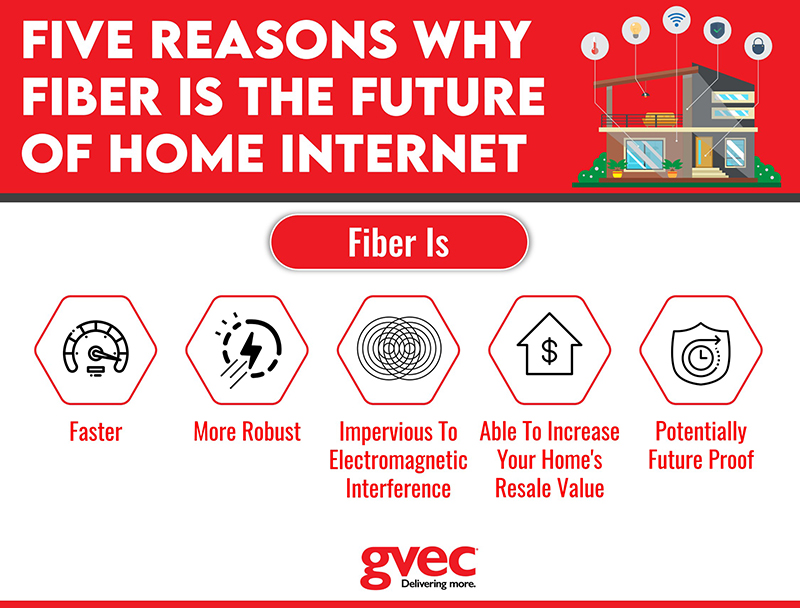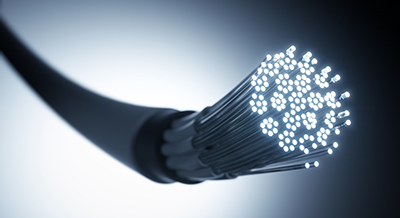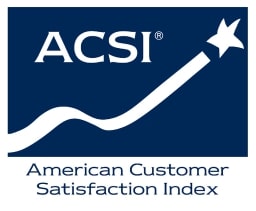GVEC Internet Internet launched our Fiber to the Home pilot project back in 2013 for a simple reason: On a number of critical technical factors, no other internet-delivery technology comes close to matching the strengths of fiber-optics. Here are five reasons why fiber is truly the future of home internet and why, at GVEC Internet, we’ll continue upgrading more and more of our service territory to fiber-optics in the years ahead.
Fiber Is Faster
Fiber-optic cables are simply faster than any other available delivery medium—and the differences are huge. For example, GVEC Internet Fiber Internet’s current top possible speed is 1 gigabit per second (Gbps) (available in certain markets). This is around 400 times faster than the top speeds achievable through a digital subscriber line (DSL), which delivers internet data via existing telephone lines. It’s over 400 times faster than satellite-based delivery and most wireless options. GVEC Internet Fiber’s top speed is more than double the top achievable speeds with cable-based internet.

Regardless of the delivery tech or the provider, it’s important to keep in mind that the above numbers are based on download speeds—which is what’s prominently advertised on every internet plan. Upload speed often gets lost in the shuffle, but it’s one of two aspects of internet speed where fiber-optics truly stands apart from the competition. Uploads are many times slower than downloads for every delivery technology out there—except for fiber-optic cable. With fiber internet, upload and download speeds are identical. This is known as symmetrical speed.
What’s the other area where fiber-optic delivery outpaces the competition? Latency. This is another aspect of speed not generally advertised with an internet plan, but it’s nonetheless important—especially for gamers. Latency is the amount of time it takes a request for information to be sent and received between an internet connection and the ISP (internet service provider). It’s measured in milliseconds (ms), and the lower the ms, the better. Of all the delivery technologies mentioned, satellite internet is the most notorious for having high latency numbers; those numbers are a big part of why this delivery type often provides an underwhelming experience. For cable, DSL and other delivery types, latency rates vary, but regardless, none compares to fiber-optic latency.
Fiber Is More Robust
No other physical delivery medium can match the sheer resilience of fiber-optics. This owes to the materials used to make fiber cables—thin strands of glass—and the way in which fiber-optic data is transmitted—pulses of light. The “fiber” in “fiber-optics” refers to those thin strands, which are slightly larger in diameter than a human hair. This helps make fiber-optic cables light-weight and tough. In comparison, the copper wiring used in other delivery mediums is downright bulky.
Additionally, unlike copper-based mediums, the glass material in fiber cables is extremely resistant to corrosion and deterioration. Copper is a material that naturally degrades over time. The transmission of electric current through the material in the delivery of internet service contributes to this effect. To date, a slow, natural decline like copper’s hasn’t been observed in fiber-optic cables. Granted, fiber-optic infrastructure isn’t nearly as widespread and neither has it been in use as long, but the laws of science apply: Glass materials simply aren’t vulnerable to the same corrosive, oxidizing forces seen in a metallic material like copper. Neither do fiber cables transmit electricity—only light pulses, giving them further protection against deterioration.
This property of fiber-optic cables—their built-in resistance to corrosion—combined with their use of light for data transmission instead of electrons also makes them far more resistant to weather and other environmental factors compared to copper-based mediums.
Fiber Is Impervious To Electromagnetic Interference

This susceptibility to interference also makes copper-based systems less secure. Data (including voice calls) transmitted across copper systems can more easily be intercepted by third parties compared to fiber-optic systems.
Fiber’s natural resistance to outside influence gives it another important advantage, too: greater flexibility in the placement and positioning of cables. When building out fiber infrastructure, developers needn’t worry about proximity to other electrical or radio-based systems or devices. This can allow for build-outs that are more flexible, wide-ranging, and efficient.
Fiber Can Increase Your Home’s Resale Value
Yes, you read correctly: Having access to fiber internet can potentially increase your home’s resale value—or so suggests a 2015 study conducted jointly by the University of Colorado at Boulder and Carnegie Mellon University, and funded by Fiber to the Home Council Americas, among others.
This study, based on data from 500,000 home sales between 2011 and 2013, found that access to high-speed fiber internet can add as much as 3.1% to the value of a home. We can think of few other real-world, on-the-ground results that more strongly suggest fiber is truly the future of home internet.
Fiber Is Potentially Future Proof
As any IT professional will tell you, there are few—if any—truly future-proof technologies. Like most other inventions through time dubbed “future proof,” it’s quite possible that, despite fiber’s superior resilience, security and data capacity, some other technology will be discovered or developed in the years ahead that make it passé. At the moment, however, this seems unlikely.

We know beyond doubt that fiber infrastructure will soundly outlast copper-based systems and require far less maintenance in the process. To date, we simply don’t have enough data to fully understand how much longer fiber can physically outlast copper. Here’s the thing about fiber technology that gives it real future-proof potential, though: The top speeds of current fiber internet technology are measured in Gbps. However, those current maximum speeds are not the theoretical maximum that existing fiber infrastructure is capable of transmitting. Studies suggest that fiber cabling—in its present form—is capable of carrying far more. In fact, fiber’s bandwidth capacity might well be infinite—theoretically speaking, of course.
So what gives? Why don’t we have fiber internet service in the 100 Gbps range? Heck, if fiber’s bandwidth capacity is infinite, why don’t we see connection speeds in the 1 terabit per second range or even higher? The restriction lies in the equipment at either end of fiber infrastructure that compiles, collates and transmits data across the cabling. At this point, equipment with those capacities for home-based internet doesn’t exist, and it’s difficult to predict when, if ever, it will.
That’s not to say fiber internet service can’t or won’t continue increasing beyond the Gbps range. Researchers and service providers are continuously seeking and developing new ways to increase bandwidth. Rest assured, this quest will go on…and on. The truly exciting part is that, as new equipment and techniques for increased capacity emerge, fiber infrastructure may not need to be upgraded.
GVEC Internet Fiber Internet: Building For Tomorrow In South Central Texas
In regard to fiber-based internet, the true challenge of our time is building sufficient infrastructure to meet the exploding demand for bandwidth in the decades ahead. This is why, year after year, GVEC Internet Internet is committed to expanding our fiber network to connect more of the Guadalupe Valley. We’ve got lots of room to grow, and we’re far from done: Our fiber buildout is accelerating each year. For more information on GVEC Internet Fiber Internet, call us at 800-699-4832. To find out if GVEC Internet Fiber is available in your neighborhood or when it might be coming, visit our Internet Availability Map.

